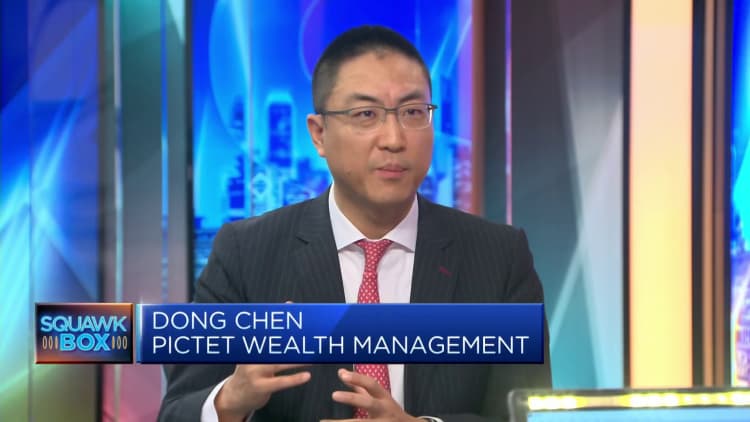[ad_1]
People are reflected in an electronic quotation board displaying the 225-issue Nikkei Stock Average (top) as they cross a street in Tokyo on May 17, 2023. (Photo by Kazuhiro NOGI / AFP) (Photo by KAZUHIRO NOGI/AFP via Getty Images)
Kazuhiro Nogi | Afp | Getty Images
Japan’s stock markets have been testing new highs not seen since 1990 — evoking memories of its “bubble economy” right before the country plunged into its so-called “lost decade.”
Since late May, the Nikkei 225 has breached the 30,000 mark, a feat not seen in 33 years.
To be clear, the benchmark index is still about 18% below its all-time high, when the Nikkei hit 38,915 on Dec. 29, 1989.
The bubble burst after the Bank of Japan tightened monetary policy at the start of 1990, triggering the collapse of equity and land prices. By September that year, the Nikkei index crashed to just half its record high.
But analysts who spoke to CNBC said Japan is not headed for another crash like the one during the bubble.
“It is very difficult to argue that Japan is facing the same situations as in the late 1980s,” said Dong Chen, head of macroeconomic research at the private bank Pictet.
Ryota Abe, an economist with the global markets and treasury department at Sumitomo Mitsui Banking Corporation, shared the same sentiments.
“We do not see a bubble in the economy,” he said, pointing out that while real estate prices in metropolitan Tokyo have skyrocketed and inflation rates are at the highest in decades, it is not a nationwide phenomenon but is only seen in some areas in Tokyo.
Furthermore, “current high inflation rates in Japan are due to higher import costs on the back of a weaker yen and high commodity prices. We cannot call it a bubble,” Abe added.
What led to Japan’s bubble?
Rapid growth in Japan’s economy, low unemployment, and easy access to credit in the 1980s powered the stock rally at that time.
The Bank of Japan’s interest rates then were at 2.5% — its lowest since the central bank transited to a floating exchange rate in the early 1970s.
Low borrowing rates fueled speculation, which drove up stock markets and led to an asset price bubble.
As the BOJ raised interest rates, the world’s third largest economy plunged into a decade-long crisis that came to be known as “Japan’s lost decade” — a period of slow to negative economic growth that continues today.
Over the last two decades, Japan’s GDP grew by an average of 0.7% from 1991 to 2011, and from 2011 to 2019, Japan’s GDP grew just under 1%.
Different this time
The stock market rally this time is different, said Abe, and the outperformance of the Nikkei can also be attributed to a few other factors.

First, listed firms have posted better-than-expected financial results, thanks to a weak yen, which makes Japanese products comparatively cheaper than their competitors.
As a result, Japanese companies have seen stronger economic performances overseas.
In addition, more Japanese firms have bought back their stocks in response to the Tokyo Exchange Group’s push for greater capital efficiency.
Nikkei reported in March that share buybacks by Japanese companies was set to reach their highest level in 16 years.
Reforms taking effect
Japan has seen “some structural changes” in the the past decade too, led by the late Prime Minister Shinzo Abe who took office in 2012 and implemented his so-called “Abenomics” policies, Chen pointed out.
The prime minister’s signature economic policy is based on the “three arrows” of increasing money supply, increasing government spending, and economic and regulatory reforms to make Japan more globally competitive — Chen said the third arrow may finally be seeing some results.
Most notably, he pointed out, Japanese corporate spending has been ticking higher, which means companies are investing again.
A June 23 report by Nikkei found that capital investment by Japanese companies is set to hit a record 31.6 trillion yen ($221.03 billion) in the 2023 fiscal year.
The report said domestic investments — at around two-thirds of the total — are expected to see double-digit percentage growth for the second straight year, while overseas investment could increase by 22.6%, marking a third straight year of double-digit expansion.

Chen said it means Japanese companies may have broken out of the so-called “balance sheet recession” mentality, where households and businesses aimed to reduce debt, instead of engaging new investment.
“Now we’re seeing the opposite, meaning they’re actually investing because they haven’t invested for so long … we think this trend probably can last longer.”
Spurred by foreign interest
Foreign investors have also taken a renewed interest in the world’s third largest economy.
Japan’s economic recovery has started, and there have been notable changes in the business environment — such as higher wage growth in 2023, Abe from SMBC pointed out.
Overseas investors have found opportunities in Japan, thanks to the lower value of the yen and possible higher upside potential for equities.
Billionaire investor Warren Buffet’s bullish outlook on Japanese equities has also piqued investor interest in Japan.
There are also external factors boosting optimism about Japan.
Global companies are now diversifying supply chains away from China, and Chen said Japan could benefit as one of the destinations to reshore supply chains, “particularly in the very high end, more technologically dense sectors like semiconductors.”
“All these things are pointing to the right direction, we think that there are reasons to be more structurally positive about Japan than before,” he added.
The way forward
The Bank of Japan will be a key player in whether or not the stock market will continue to power ahead.
As mentioned, when the BOJ’s tightened its monetary policy at the start of 1990, Japanese markets tumbled.
Now, with new BOJ governor Kazuo Ueda expected to walk the BOJ out of its ultra-dovish stance, is such a future ahead for the market?
Oliver Lee, client portfolio manager at Eastspring Investments, a subsidiary of British insurer Prudential, told CNBC that with inflationary pressures building in Japan, monetary policy could become “marginally tighter” in the next 12 months.
“Short term technical indicators look elevated and it would probably be healthy to see a pause in the market, or even a small correction,” Lee predicted.
However, the long-term investment case in Japan remains robust, Lee said, citing improved underlying corporate profitability and ongoing corporate governance backed by institutions like the Tokyo Stock Exchange.
Most notably, Lee pointed out that most international investors are still underweight Japan in their portfolios.
With the trend of corporate share buybacks expected to continue, he said demand for Japanese equities should remain strong heading into the second half of the year.
[ad_2]

